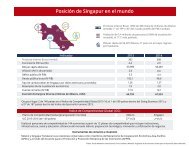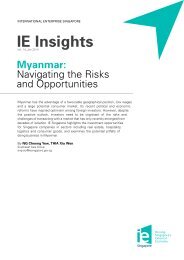basic-guide-to-exporting_Latest_eg_main_086196
basic-guide-to-exporting_Latest_eg_main_086196
basic-guide-to-exporting_Latest_eg_main_086196
You also want an ePaper? Increase the reach of your titles
YUMPU automatically turns print PDFs into web optimized ePapers that Google loves.
When goods enter a bonded warehouse, both the importer and the warehouse proprie<strong>to</strong>r incurfinancial and l<strong>eg</strong>al liability under a bond. The liability is canceled when the goods are:• Exported• Withdrawn for supplies <strong>to</strong> a vessel or aircraft in international traffic• Destroyed under U.S. Cus<strong>to</strong>ms and Border Protection supervision• Withdrawn for consumption within the United States after payment of dutyYour company could enjoy several advantages by using a bonded warehouse.• No duty is collected until merchandise is withdrawn for consumption. An importer has controlover use of money until the duty is paid on withdrawal of merchandise from the bondedwarehouse. If no domestic buyer is found for the imported articles, the importing companycan sell merchandise for exportation, thereby canceling the importer’s obligation <strong>to</strong> pay duty.• Many items subject <strong>to</strong> quota or other restrictions may be s<strong>to</strong>red in a bonded warehouse.• Check with the nearest U.S. Cus<strong>to</strong>ms and Border Protection office, however, before placingsuch merchandise in a bonded warehouse.• Duties owed on articles that have been manipulated are determined at the time of withdrawalfrom the bonded warehouse.Intellectual Property ConsiderationsIntellectual property (IP) refers <strong>to</strong> a broad collection of rights relating <strong>to</strong> works of authorship,which are protected under copyright law; inventions, which are protected under patent law;marks, which are protected by trademark law; and designs and trade secrets. No internationaltreaty completely defines these types of intellectual property, and countries’ laws differ insignificant respects. National intellectual property laws create, confirm, or r<strong>eg</strong>ulate a propertyright without which others could use or copy a trade secret, an expression, a design, or a produc<strong>to</strong>r its mark and packaging.The rights granted by a U.S. patent, trademark r<strong>eg</strong>istration, copyright, or mask work (design of asemiconduc<strong>to</strong>r chip) r<strong>eg</strong>istration extend only throughout the United States and its terri<strong>to</strong>ries andpossessions. They confer no protection on your company’s product in a foreign country. There isno such thing as an international patent, trademark, or copyright. To secure patent or mask rightsin any country, you must apply for the patent or r<strong>eg</strong>ister the mask work in that country. Whilemost countries require r<strong>eg</strong>istration of trademarks in order <strong>to</strong> secure protection, others grant rightsthat are based on priority of use in that country. Copyright protection depends on national laws,but r<strong>eg</strong>istration is typically not required. There is no real shortcut <strong>to</strong> worldwide protection ofintellectual property. However, some advantages and minimum standards for the protection andenforcement of intellectual property exist under treaties or other international agreements.International AgreementsThe oldest treaty relating <strong>to</strong> patents, trademarks, and unfair competition is the Paris Conventionfor the Protection of Industrial Property. The United States and more than 160 other countries areparties <strong>to</strong> this treaty. The Paris Convention sets minimum standards of protection and providestwo important benefits: the right of national treatment and the right of priority.Chapter 10: International L<strong>eg</strong>al Considerations111





